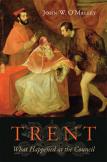A Legacy Brought to Life
Every historian of early modern Christianity that I know would agree: in 1993 John O’Malley, S.J., put us all in his debt with the publication of The First Jesuits. This year he moves us deeper into the red with his new book Trent: What Happened at the Council. Let me try to explain why.
Who could deny that the Council of Trent (1545-63) was influential? Many of the most prominent features on the landscape of early modern Catholicism (1563-1962) can be traced to that council. O’Malley enumerates some of these: Trent gave rise to (a) a church that was more strongly sacramental than ever; (b) a church in which there was more and better preaching than ever before; (c) a more highly educated clergy; (d) a new, much tighter control over the sacrament of matrimony; (e) more bishops residing in their own dioceses than there had been in many centuries; (f) a Catholic devotional style that minimized the Bible; (g) five centuries of intellectual life overshadowed by the Index of Forbidden Books; (h) five centuries of Catholic historiography that focused on “unbroken continuity;” and so forth. These developments can scarcely be understood without studying the Council of Trent. Some of us read the decrees and canons of the council and leave it at that. Others dig deeper, and a very few become experts.
This last step entails an arduous rite of passage: a close encounter with the infamous acta—the “proceedings” of the council. There are three scholars who I am morally certain have read through all 13 volumes: Hubert Jedin, then Jaroslav Pelikan and now John O’Malley. For those who have never even turned a page of this turgid leviathan, a word of advice: Don’t take it with you to the beach! It could be compared to the Congressional Record from a term with a newly elected president and a lame duck Congress: much hot air, with weighty decisions being made elsewhere. So, on this score alone, my hat is off to O’Malley.
A recurring theme in Trent that piqued my curiosity was the issue of participation in the council. It was, as is commonly known, miserable. Out of some 700 bishops who were invited, 29 showed up for the beginning of the council. The second period opened with 15 bishops in attendance. And in the third period, after much papal arm-twisting, numbers soared to around 200. Why this reluctance, this weak episcopal enthusiasm? On this question, and others like it, Father O’Malley is superb. He details the somewhat limited physical attractions of 16th-century Trento. He identifies the scarcity of suitable lodging as a factor. Periodic outbreaks of the plague in Trent no doubt put a damper on things. And some bishops certainly were deterred by costs. The one, for instance, who arrived with an entourage of 160 could not possibly stay for the entire seven month debate on justification! Others, even with a more modest support staff, refused to come at all unless the pope was paying. Any initial sense of urgency among the bishops would surely have been quickly deflated by such considerations.
But was there not more to it than this? Would it be too much to suggest that the bishops simply did not think that anything of great importance was going on here? Father O’Malley does not say this, but he does drop hints pointing in this direction. A significant number of bishops arrived and then left after a few days. It seemed clear to many that the three successive popes (Paul III, Julius III and Pius IV), though they never showed up in Trent, completely dominated the agenda and discussions through their legates. A small joke circulating at the time had it that the Holy Spirit, instead of descending on the bishops, arrived every day in the mailbag from Rome. True, in Father O’Malley’s account, he occasionally uses terms like “crisis,” and even “drama.” His summation, however, sounds more monotonous: it was, he says, “a seemingly endless 18 years.” And in his telling, the word “tedium” crops up more than once.
I fasten on this, I confess, because of personal experience. For more than three decades I have taught university courses on Christianity in the early modern period. Students, undergraduate and graduate, can get excited about Luther, or agitated about Calvin, or bemused by the Marburg Colloquy, or angry about Henry VIII. They find Erasmus interesting and Ignatius Loyola even more so. But when we come to Trent, eyes glaze over in the first five minutes, and soon thereafter comes the collective yawn. Perhaps the fault is mine. But I do try the usual tricks: I digress into Pope Julius III’s private life, for instance, or I describe how the debate on justification devolved into episcopal shouting and beard-pulling. The tedium lifts, but only briefly.
And now, as though coming to my rescue, John O’Malley’s book appears on the scene. It is quite simply the most engaging book on the council that I have read. Written by a scholar who is undoubtedly an expert on this subject, it is accessible to students at the graduate and advanced undergraduate level. They may slumber through my lectures, but for Father O’Malley’s Trent, they’ll be wide awake.
This article also appeared in print, under the headline “A Legacy Brought to Life,” in the March 18, 2013, issue.








